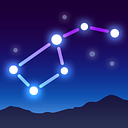Throughout August, you’ll have a chance to spot four bright planets near the Moon. Learn here about these conjunctions and choose the most noteworthy one! Spoiler alert: we strongly advise you not to miss the conjunction of the Moon and Jupiter.
What does a conjunction with the Moon mean?
In astronomy, a conjunction is an apparent event that occurs when two or more space objects are visible very close to each other. In general, conjunctions take place between the Moon and planets (Venus, Mercury, Mars, Jupiter, or Saturn).
Obviously, planets don’t get closer to the Moon in space — it would indeed cause a significant impact on the Solar System. The space objects only seem to be close in the sky for the observers from the Earth.
August 10: Moon-Mars conjunction
On August 10, 2021, at 00:42 GMT (or August 9, at 8:42 p.m. EDT), the Moon will pass 4°17' to the north of Mars. At the night of conjunction, the thin, only 4% illuminated Moon will shine at a magnitude of -8.7; the reddish Mars will be at a magnitude of -2.9. Both sky objects will be placed in the constellation Leo. The Moon and Mars will be too widely separated, so don’t use a telescope for observation — try a pair of binoculars or naked eyes instead.
By the way, it might be your last chance to observe the Red Planet this year! The planet is already quite faint and keeps fading in the Sun’s glare, moving towards its solar conjunction that will take place on October 8, 2021.
August 11: Moon-Venus conjunction
Only a day later, on August 11, 2021, at 06:59 GMT (02:59 a.m. EDT), the conjunction of the Moon and Venus will occur — the Moon will pass 4°17' to the north of Venus. Our natural satellite gains brightness rapidly, and on the day of the close approach to Venus, the Moon will be shining at a magnitude of -10.0. Venus, in its turn, is the most prominent planet in the sky and will have a magnitude of -4.0. Look for them in the constellation Virgo.
August 20: Moon-Saturn conjunction
The next conjunction will take place on August 20, 2021, at 22:15 GMT (6:15 p.m. EDT). This time the 95% illuminated Moon will meet with Saturn in the constellation Capricornus, lying 3°42' to the planet’s south. The celestial bodies will shine at magnitudes of -12.6 and 0.2, respectively.
Saturn just recently reached an opposition, which means that the planet is at its brightest of the year now. The planet is almost opposite the Sun in the Earth’s sky and is visible most of the night. Saturn isn’t as noticeable to the unaided eye as the next planet on our list, Jupiter; however, when observed through a telescope, Saturn provides a truly stunning view.
August 22: Moon-Jupiter conjunction
On August 22, 2021, at 04:56 GMT (12:56 a.m. EDT), you’ll have a chance to spot bright Jupiter near the Full Blue Moon in the constellation Capricornus; our natural satellite will pass 3°57' to the south of the gas giant.
Jupiter will also reach an opposition on August 20, 2021, shining at its brightest. It will be much more luminous than Saturn, shining at a magnitude of -2.9. Even the 100% illuminated Moon won’t outshine its glare.
How to see a Moon-planet conjunction?
Here is what you need to know in advance:
1. Space objects rise and set time for your location. There is a possibility that an object will rise above the horizon during the daytime, so you won’t be able to see it at all.
2. The Moon phase. The fully illuminated lunar disk is, without doubt, an exciting view, but it also hides some relatively faint objects that are close to it.
3. The space objects’ trajectory across the sky. It will help you to visualize the future movement of space objects.
Remember that depending on your timezone, you might miss the exact moment of conjunction, but you still have a chance to catch a planet close to the Moon.
With the stargazing guide Star Walk 2, you’ll quickly find out all the necessary information. For the set and rise times and the Moon phase, use the Sky Live section. To see how space objects move across the sky over time, use the Time Machine feature.
So this was all you needed to know about the four conjunctions with the Moon this month. If you enjoyed the article, share it on social media.
Wishing you clear skies and happy observations!
